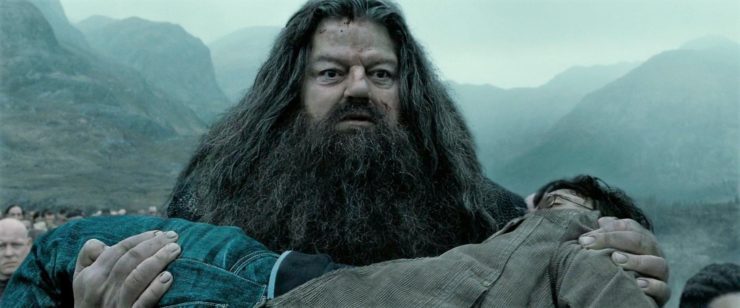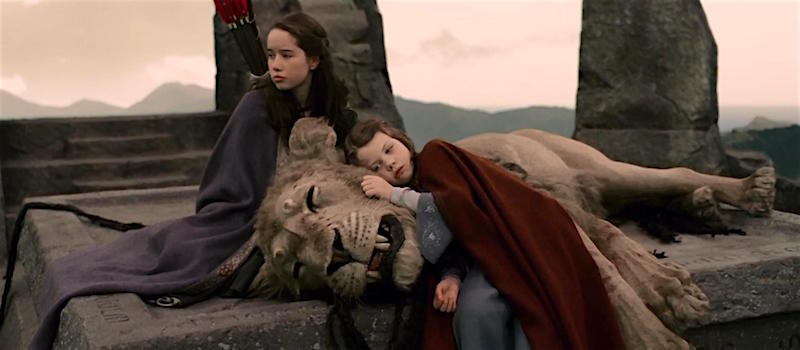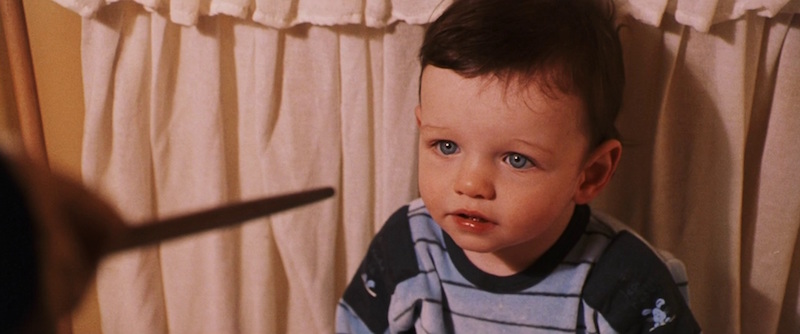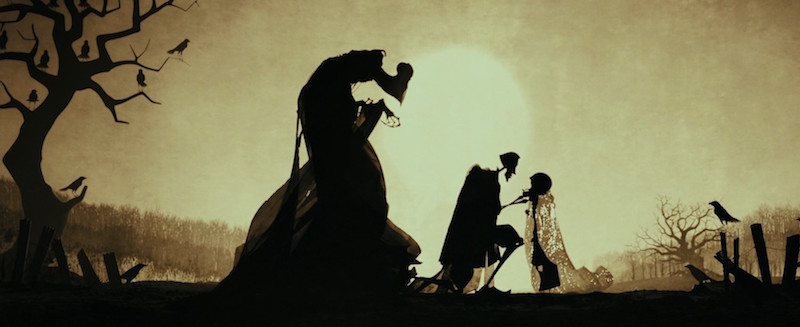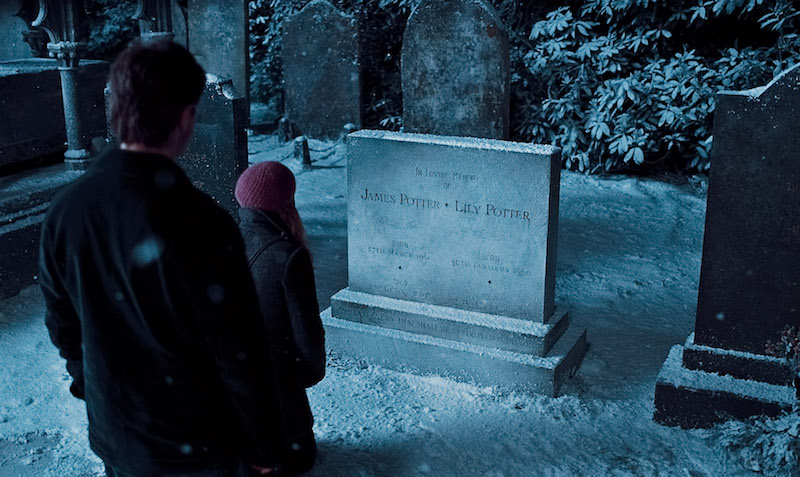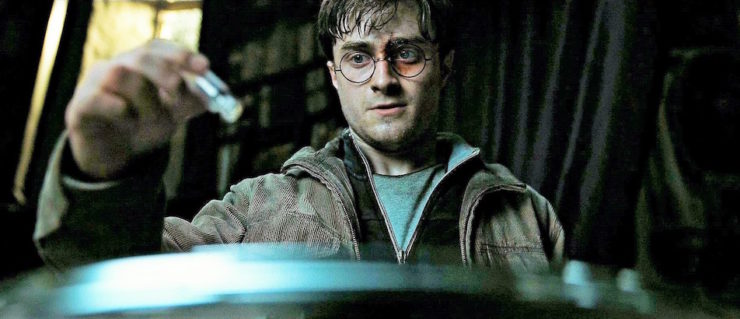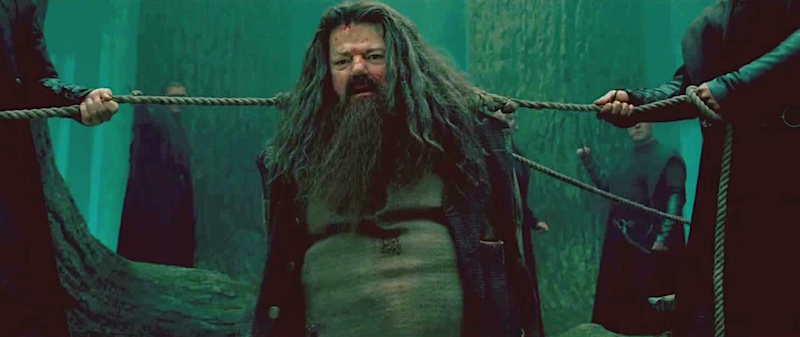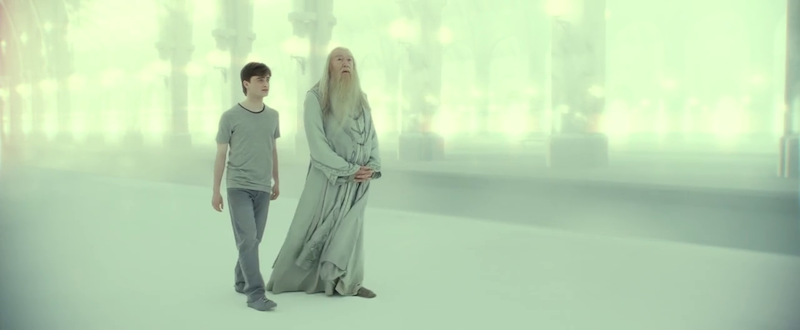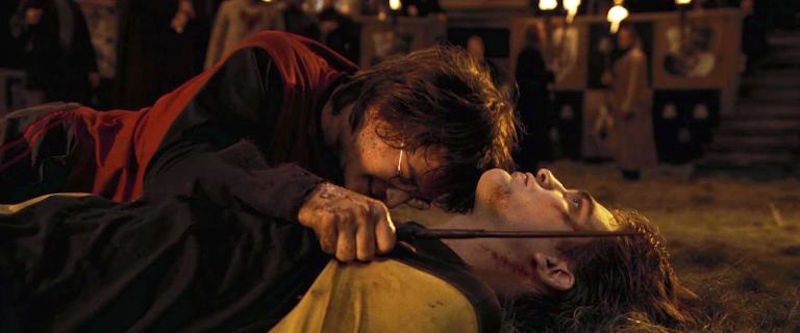Harry Potter and the Cursed Child has been on Broadway for about six months and collected six Tonys after a successful run in London. I was lucky enough to see the play a few months ago, and while I liked it enormously, I can’t stop thinking about how odd it is. With Cursed Child, Rowling foregoes the possibility of a simple fun adventure and instead adds a coda to the series-long meditation on death, and continues her ongoing tickle fight conversation with the moral fantasy of C.S. Lewis.
Has there ever been a blockbuster/franchise/pop-culture-phenomenon more death-obsessed than Harry Potter? The Narnia books at least give us pages full of whimsy and adventure before cranking the stakes up. Death looms over The Hunger Games, obviously, but the books are also about political strife and governmental overthrow and class warfare. Star Wars tends to sanitize its deaths, with lightsabers cauterizing wounds and Jedi masters literally disappearing so there isn’t any gore to confront. And when you look at The Lord of the Rings? Sure, death is pretty much Mordor’s Big Mood—but Tolkien’s books are as much about hope and battle and honor and gardening and the powerful love between an elf and a dwarf as they are about mortality.
The Harry Potter books are about death in a way that the others are not, and about the different ways of responding to its inevitability: a villain whose entire life revolves around finding immortality no matter the cost; a hero haunted by witnessing his parents’ deaths; a wizard supremacist cult literally called the Death Eaters; the endless speculation that began just before Book 4 came out about WHO WOULD DIE; the dawning realization that at least one beloved character was going to die in each book from #4 onwards; horses that were only visible to people who have lost loved ones; gallows humor throughout; and three magical MacGuffins called The Deathly Hallows.
Rowling begins her story mere minutes after James and Lily’s murders with a focus on Harry’s scar—his death, really, waiting in his head—and ends it with a resurrected hero who goes out of his way to destroy magical access to immortality. And hovering around all of this is the question of what comes after death—whether the ghosts of Lily and James are truly conscious ghosts or just a sort of echo, and what it will mean for Harry to fulfill his destiny and die.
Which makes it all the more interesting that the HP series is resolutely, gloriously secular. The magic the wizards and witches use is hard work, and requires training and homework. There are few miracles, aside from the occasional assist from the Sorting Hat or Fawkes; the students and their teachers have to rely on themselves to defeat evil. Prophecies are potential futures to be dealt with, not Capital-A apocalypses. Where many fantasy series either encode Christianity into their DNA (The Lord of the Rings, Narnia) or create religions for their characters to follow (The Stormlight Archive, Star Wars) the characters of the Potterverse celebrate Christmas and Halloween as cultural holidays with trees for one, pumpkins for the other, and chocolate for both. There is never any sense that the kids practice the Christianity of Christmas or the Celtic Paganism of Samhain. There’s no mention of High Holy Days or Ramadan fasts. There are no non-denominational chapels in Hogwarts. The one wedding we attend is at the Burrow, and someone described only as a “small, tufty-haired wizard” presides over the lone funeral.
But in the midst of this secularism, Rowling uses Christian imagery, returning to them over and over again and infusing them with new meanings each time. She riffs on them in ways that startled me when I read the series the first time, and I was astonished when she returned to them and remixed them again for Cursed Child. When I watched the play I found myself thinking again and again about the stark contrast between Rowling and C.S. Lewis.
Though The Last Battle wasn’t published until 1956, Lewis finished the Chronicles of Narnia before he met, married, and lost Joy Davidman. He explored the liminal time of mourning in A Grief Observed, publishing the book in 1961 under the pseudonym N.W. Clerk—he didn’t want people who read his apologetics or his children’s fantasies stumbling across such a raw, painful work. (It was only after his own death in 1963 that the book was republished under his name.) While I don’t feel that I’m qualified to psychoanalyze Lewis, I do think it’s worth noting that The Last Battle, with its hardline theological attitude toward Susan, and its conception of Tash as simply evil, was written before Lewis’ spirituality was reshaped by grief, whereas Rowling wrote the Harry Potter series largely in direct response to nursing her mother through a long final illness. She was still reeling from that loss (as well as the ending of her first marriage and the birth of her first daughter) when she began writing a series about the consequences of trauma, and the ongoing pain of mourning. So why am I dragging Lewis into this?
He and Rowling each wrote hugely popular—and completely different—rewrites of Christianity.
Rowling has spoken about her uneasiness with the way Lewis encodes a theological agenda into his books. Because Lewis’ books, much like Tolkien’s, don’t just toss in a Nativity or a general idea of sacrificing oneself for the greater good—they entwine hardcore theology and theodicy into the entire series, and create action that hinges on that theology.
Hang on, does everyone know what theodicy is? It’s basically “the problem of evil” or the study of why an omnipotent, omniscient, and benevolent God would allow evil in the world It created. The term was coined by Gottfried Leibniz (one of the two men who invented calculus!) in 1710, in a book helpfully titled Théodicée, but the idea has been around much, much longer. There are many different schools of theodicy and anti-theodicy (some which sprung up as direct responses to the horror of the Holocaust, for instance) and C.S. Lewis dug into it with several books, specifically Mere Christianity, The Problem of Pain, and A Grief Observed. Mere Christianity, for instance, tackles free will by comparing God to a mother who tells her child to clean its room. Sure, this might fail—the child might ignore its mom, leave the room messy and never learn the value of cleanliness—but by offering the child the choice to clean its room or not, the mother is allowing the kid to grow up, determine its own living space, take pride in its cleanliness, and generally become a better, more responsible adult. C.S. Lewis applies the same logic to God, saying: “It is probably the same in the universe. God created things which had free will. That means creatures which can go either wrong or right” and even though humans can do evil things, and create great suffering, having free will is better than the alternative because “free will, though it makes evil possible, is also the only thing that makes possible any love or goodness or joy worth having.”
This idea is baked into every page of the Narnia books.
Narnia is essentially a series explaining free will, the problem of pain, and faith to children through exciting stories and cute animals. The Lion, The Witch and the Wardrobe starts off fun and whimsical: Lucy finds the cupboard! Beautiful snowy woods! Lamppost! Tumnus! But soon it’s revealed that the kids have stumbled onto a cosmic battle. Edmund shows us the dark side of free will (and the need to remain morally vigilant in the face of Turkish Delight) by using his freedom to betray his siblings and Aslan, while the White Witch shows us the evil of ultimate selfishness, and Aslan presents another side of free will. The mighty lion, who has seemed comforting and omnipotent to the abandoned children, hands himself over to the Witch so he can be a willing sacrifice in exchange for the traitorous Edmund. Though he could easily escape, he chooses to be tortured, to allows them to manhandle him and shave his mane. He allows himself to be humiliated.
Susan and Lucy, having followed Aslan, are asked to act as silent, helpless witnesses. Finally, once Aslan is really most sincerely dead, the White Witch and her followers gloat over his corpse, and leave it to rot. Lucy and Susan stand watch over Aslan’s ruined body, and their loyalty is rewarded when they are the first witnesses to his resurrection. This is all, note for note, the arc of Gethsemane, the Crucifixion, and the Resurrection, with Edmund playing the Judas role and the girls standing in for the various Marys and Magdalenes. And as in the Christian story, the important part is the willingness of the sacrifice. Lucy and Susan are seeing someone with enormous power relinquish that power for a larger purpose, but they don’t know that a long-game scenario is playing out, they just know that they love their friend and they’re going to stay with him until he gets a proper burial.
Then their faith in Aslan is confirmed when he comes back even stronger than before. Death doesn’t win—and Aslan reveals that there is a “deeper magic from before the dawn of time” (a magic the White Witch knows nothing about) which will resurrect an innocent being who has given his life for a traitor. This is only the barest allegorical gloss slapped over Christian theology, with Aslan acting as a stand-in for Christ, and the human race being a big bunch of Edmunds, betraying each other and ignoring moral law in favor of all the Turkish Delight life has to offer.
Aslan is presented as a deity figure who is actually worshipped, not just loved—he appears as a lamb in The Voyage of the Dawn Treader, and is revealed to have created Narnia itself in The Magician’s Nephew. He also appears as a supernatural bogeyman to the followers of Tash—Aslan’s power simply translates into its evil counterpoint for them. When the series culminates in The Last Battle, it’s revealed that faith in Narnia/Aslan has allowed all the “Friends of Narnia” to return (and that Susan’s lack of such faith left her on Earth), and that all “good” followers of Tash get to come along to a Heaven that is sort of a deluxe Narnia: “I take to me the services which thou hast done to Tash… if any man swear by him and keep his oath for the oath’s sake, it is by me that he has truly sworn, though he know it not, and it is I who reward him.”
In this way Lewis creates a stand-in messiah, twines the quasi-Jesus story around the core of his fantasy series, and riffs respectfully on Christian theology. He takes the somewhat liberal (and controversial, in some theological circles) Inclusivist stance that good works can get people into paradise apart from their conscious faith in his specific savior figure. He also obliquely returns to the idea of pain as a force for growth with the character of Susan.
How could Aslan allow Susan to survive the train crash that kills her entire family? Well, if you want to a theodical interpretation, grief will teach her more about the importance of faith in her life, until she’s ready to come back to Aslan, believe in Narnia, and rejoin her family. Unnecessarily harsh for a series of children’s books, you say? Lewis was trying to put forth a very specific theological idea, which was that having free will meant you had the ability to fuck up as Edmund and Susan both do. As a true Friend of Narnia, you need to keep faith with Aslan, and be obedient to him. Lewis’ moral lesson is to trust your elders and your God, and his books are essentially softening his young readers’ hearts for lives spent believing in Christianity.
Sometime early in the writing of her Harry Potter books, Rowling also decided to weave Christian symbolism into the story, but arrived at a very different moral conclusion than Lewis.
Rowling effectively collapses the Nativity and the Crucifixion into one scene: Harry as an infant is helpless in his crib when Voldemort comes to visit. (An inversion of the Three Kings? Or maybe a nod to Maleficent.) James tries to stop him and is easily cast aside (the human father, like Joseph, being a background character compared to the Chosen One’s mother), and it’s Lily who steps up and sacrifices her life for Harry’s. She replaces her son’s death with her own, and invokes a type of love that is a deeper magic than Voldemort can understand. This mirrors the “deeper magic from before the dawn of time” that brings Aslan back to life, to the chagrin of the White Witch.
This is the moment that makes Harry Potter who he is. Not just in the sense that he’s a celebrity orphan, but that he is now on a path created by a sacrifice that will lead to a second sacrifice. It began with a green flash that meant his death, and it ends in facing that death all over again. Rowling seeds this throughout the series: the Mirror of Erised shows him his family, whole and happy. The Dementors force him back into a memory of his last moments with his parents—and in a fantastic twist, he realizes that he almost welcomes the Dementor’s Kiss because it triggers those memories. When Harry faces Voldemort for the first time in Goblet of Fire, the shades of his parents emerge from the wand and protect him.
In almost every book Rowling finds a way to check back in with that origin scene, reworking it from different angles, refracting it through different lenses. Harry’s parents’ deaths are interrogated repeatedly, much as the Nativity is relived through the Peanuts gang, and generations of Sunday School Christmas pageants, and the Crucifixion is reinterpreted through Passion Plays, productions of Jesus Christ Superstar, and the occasional Martin Scorsese film. Just as every Midnight Mass homily revisits the Nativity, so all the major Harry Potter characters find ways to retell stories about The Boy Who Lived. Just as Andrew Lloyd Webber, Tim Rice, and Nikos Kazantzakis each retell Jesus’ crucifixion through the point of view of Judas, so Rowling shows us Harry’s memories of that day, Sirius’ memories of being the Potters’ Secret Keeper, Hagrid’s first moments with Baby Harry, Aunt Petunia’s insistence that her sister died in a car crash. This eternal return begins to feel like an obsession by Prisoner of Azkaban, but Rowling was just getting started.
With Goblet of Fire, Rowling backs off (slightly, temporarily) on reliving That Day, and instead kicks the series into high gear with a remorseless killing spree. Harry watches Cedric die, then Sirius, then Dumbledore, then Dobby, then Snape. Bill Weasley is maimed and George loses an ear in Death Eater attacks. The Ministry falls, and the wizarding world collapses into Magical Fascism. Harry even gets his own Judas figure in Peter Pettigrew, who betrays the Son as he betrayed the Parents. Throughout all of this, with the terrifying wizard of our collective nightmares gaining more and more power, at no point does anyone offer any sort of religious structure, theology, belief system, theodicy, nothing. Or, well, almost nothing.
We get the stories of the Deathly Hallows themselves, in which Rowling teases real magical artifacts in the Tales of Beedle the Bard—which most mature wizards think of as bedtime stories for their children. (This in itself is an interesting twist: the stories Ron dismisses as juvenile fables turn out to not only be true, but vitally important to Voldemort’s defeat.)
Finally, Rowling makes a point of intersecting her Wizarding story with the Muggle world by placing James and Lily’s house in Godric’s Hollow, across the street from a church. She shows us the gravestones of the Dumbledore family and the Potters, which read “Where your treasure is, there will your heart be also,” and “The last enemy that shall be destroyed is death,” respectively. The first is a memorial to Dumbledore’s mother and sister, an acknowledgement of his love for them despite all of his ambition and a life spent at Hogwarts. It’s also a quote from the New Testament: Matthew 2:21. The Potters’ shared stone is a nod to the Deathly Hallows (and a slightly on-the-nose reference to the theme of the entire series) but it’s also 1 Corinthians 15:26. Given that up to this point the series has been resolutely secular, I still remember having to reread that passage a few times. Rowling gave us an unchurched world, without even a perfunctory Church of England Midnight Mass, but suddenly Corinthians is relevant? Albus Dumbledore likes the Gospel According to St. Matthew enough to put it on his family grave? (I mean, unless he’s a Pasolini fan, but there’s no textual evidence for that.)
Of course the next notable thing to me is that Harry and Hermione seemingly have no idea what these quotes are. Neither of them have been raised with Christianity, or even a passing knowledge of the Hebrew Bible or New Testament, so this whooshes right over their heads. It’s a fascinating choice to create the alternate wizarding world, make it secular, and then, in the last book, imply that at least some people from that world also value one of the religions of the Muggle world. Especially while also making the explicit point that the two quotes are meaningless to the two main characters. Who chose the inscription for the Potters? Was it Dumbledore? The Dursleys? Some rando vicar?
But all of those questions fade into the background as Rowling uses the end of the book to dive into her second great religious remix—in this case, riffing on The Lion, the Witch and the Wardrobe’s version of the Crucifixion.
Just as Lewis did, Rowling rewrites Jesus’ dilemma at the Garden of Gethsemane. Harry hears Voldemort’s offer—he’ll end the assault on Hogwarts if Harry surrenders—and then he watches Snape’s memories in a Pensieve in Dumbledore’s office. He finally sees Dumbledore’s full plan, and realizes that his mentor had been planning his sacrifice from the beginning. Snape even accuses Dumbledore of fattening him for slaughter like a pig. Harry has to reckon with the fact that, at 17 years old, his life is over. Everything since his first birthday has been borrowed time.
This digs into an interesting debate about free will. On the one hand, Harry’s fate was sealed when Voldemort cursed him as a baby and locked him into life as the Chosen One. But on the other, Harry has to make the free, unforced choice to walk to his execution. He has to allow Voldemort to torture him, humiliate him, make him beg—no matter what, Harry, like Aslan, has to remain passive for the sacrifice to work. But this is Harry, who runs toward trouble, who jumps into action and looks for danger later, who doesn’t ask permission, who doesn’t consult teachers, who risks his life for his friends every year like it’s nothing. Harry doesn’t do passive. And we, as readers, have been trained to expect last-minute acts of derring-do (or last-minute Hermione-ideas that save the day) so it comes as a bit of a shock when Harry accepts this, works through his anger at Dumbledore, and chooses to die a second time.
Part of the point of Gethsemane is that Jesus explicitly asks to opt out of the sacrifice he’s being asked to make—theologically, this is emphasizing the human side of his nature, and giving the mortals reading/hearing the story a moment to relate to. To make it even worse, he explicitly asks his disciples—his friends—to stay up with him so he doesn’t have to spend his last night alone. They immediately pass out, which serves a ton of narrative purposes: it leaves Jesus even more bereft, demonstrates the weakness of human flesh, foreshadows the betrayals of both Judas and Peter, and serves as a symbolic warning against sleeping through a shot at redemption. (The other fascinating thing here is that you, the reader/hearer, are now essentially put in the place of either a disciple who managed to stay awake, or, if you want to be a bit more pretentious about it, God. After all, you’re the one hearing the request, right? And rest assured Rowling tweaks this element in a fascinating way that I’ll look at in a few paragraphs.)
In The Lion, the Witch and the Wardrobe, Gethsemane is sort folded into the Crucifixion, as Aslan doesn’t have any visible moment of doubt, he simply asks Lucy and Susan to stay quiet and watch his execution. (I’ll risk the assumption that Lewis wasn’t comfortable making his Jesus Lion look weak, even for a larger theological purpose.)
Rowling’s rewrite confronts this scene much more boldly. First, unlike Jesus—but like Aslan—Harry never asks to get out of his sacrifice. He wants to, desperately, but he never quite succumbs to the temptation to ask for help. Part of that could just be that Rowling has created a universe that doesn’t seem to have any sort of deity or ultimate boss to appeal to—Dumbledore is the last authority, and he’s already made it clear that he needs Harry to die. Second, unlike Aslan (and, probably, Jesus) Harry has no guarantee that he’ll be coming back—quite the opposite. He assumes he’s going to die as a Horcrux, that he’ll be completely destroyed. He accepts his own death because it makes narrative sense, basically. By dying, he can fulfill Dumbledore’s plan. Unlike Jesus, Harry at least gets to look through his history in the Pensieve, learn Dumbledore’s entire long game, and see that his loved ones will go on to live their lives free of Voldemort’s evil at last. He can choose to be angry at Dumbledore, or he can rationalize that the Headmaster hid the plan in order to allow Harry seven happy-ish years at Hogwarts—it was the only gift he could offer to make up for Harry’s miserable life with the Dursleys, and the sacrifice that lay ahead.
Harry doesn’t ask any of his friends to stay and keep him company. He explicitly avoids speaking to them because he knows that will destroy his resolve and instead visits them under the invisibility cloak so he can have a last moment of seeing them. He drops the cloak long enough to warn Neville that Nagini must be killed if Voldemort is going to be defeated, knowing that he won’t be there to see the defeat. Then he walks into the forest.
Rowling is nicer than both God and C.S. Lewis, however, because Harry isn’t completely abandoned: once again, the shades of his parents accompany him, as they did during his first real fight with Voldemort. This time they’re joined by Sirius and Lupin. The ghosts assure him that death doesn’t hurt, and that they’re proud of him. I would argue that this is the emotional climax of the series, where Harry gets all the love and validation he’s craved while coming full circle to face Voldemort. This is also a perfect narrative move on Rowling’s part, as it shows Harry in a liminal space between life and death—he makes himself a ghost with the invisibility cloak, then he is guarded by ghosts as he goes to his sacrifice in the forest. He’s being eased into death, which creates a very particular tone to the chapter. For a reader, these pages feel like taking a moment to breathe after the anger and shock of learning Harry’s destiny.
And then Harry faces Voldemort.
Harry reenacts his ancestor Ignotus Peverell’s meeting with Death when he throws the cloak off—but obviously Voldemort, who has spent his unnatural life enacting the follies of the other two brothers, does not meet Harry like an old friend. The calm atmosphere is destroyed, the ghosts are gone, and he is mocked as the Death Eaters hurl abuse at him. Worst of all, Harry sees Hagrid, the man who rescued him from the Dursleys and introduced him to a new life, abused mercilessly. He is powerless to help.
Harry is finally killed—Rowling has Voldemort finish him off with a simple Avada Kedavra, avoiding the protracted torture of Jesus or Aslan.
Of course, it’s possible to see Harry’s torture woven into his life—through Snape’s punishments, through Umbridge’s punishments, through all the painful Horcrux searches—underlining the idea that pain is simply part of life to be dealt with, not a teaching tool or a punishment from On High.
After Harry decides to come back from (ahem) King’s Cross, all the pain of being alive comes back, too; and he has to try to stay calm and play dead as the Death Eaters throw his body around like a toy—again, as with Aslan, the most important element here is humiliation, and Rowling uses this term several times. The only way to break the spirit of Dumbledore’s Army is to show them their leader broken. This was why crucifixion particularly was used on people who broke societal laws or tried to lead uprisings—not just Jesus, obviously, but Spartacus and his followers, Peter, and plenty of other would-be messiahs and revolutionaries—and why similarly horrific tortures were visited on people like civil rights workers in the 1960s, and protesters around the world today.
Simply beheading someone, or hanging them, or standing them before a firing squad isn’t going to break a movement, and martyrs only strengthen movements. You have to show the martyr’s followers that there is no hope. This is what the Romans were doing when they left people hanging on crosses for days in the sun, what kings were doing when they left heads on pikes. This is what the White Witch is doing by leaving Aslan’s body out to decay on the stone tablet. This is what Voldemort is doing when he casts Crucio on Harry’s body and flings it around like a broken doll. Voldemort orders one of the Death Eaters to replace the glasses on Harry’s face so he’ll be recognizable, which, in a single offhand sentence gives us some idea of how battered his body is. Harry can’t just be dead—he has to be desecrated. In a grotesque mirroring of the night Hagrid took Harry from the Nativity/Golgotha of Godric’s Hollow, he is forced to carry what he believes is Harry’s corpse back to Hogwarts.
Rowling has commented that she wanted the man who brought Harry into the Wizarding World to be the one who carries his body back to his true home, Hogwarts. She’s also continuing her Crucifixion imagery by riffing on the Pietá, and of course underscoring the evil of the Death Eaters, that they would make Hagrid do this. She dwells on this section, making it incredibly hard to read, I think to grind it into her young readers’ minds that this is the risk you’re taking when you resist evil. She did, after all, spend her youth working for Amnesty International—she has an intimate knowledge of the sorts of horrors tyrants visit upon dissenters. She’s showing her readers exactly what can happen when you rebel against someone who doesn’t see you as truly human. She stays in this moment far longer than I would expect from what is, essentially, a children’s book, before reassuring her readers that there’s still hope.
Harry had told Neville that someone needed to dispatch Nagini to make Voldemort vulnerable, but Neville himself still has no reason to believe they will win when he draws Gryffindor’s sword. He has every reason to believe that he is dooming himself by attacking—especially seeing what’s been done to Harry. All of them fight together, while Harry, invisible under his cloak, acts as a sort of protective angel during the last battle of Hogwarts. He defeats Voldemort with all of his friends around him, using a disarming spell to the last, and still imploring his nemesis to repent. And this is the last great subtle point Rowling makes with her main series: rather than waiting for a savior or tying everything to one guy, the Wizarding world unites into a collective to fight the Death Eaters, even in the face of impossible odds. Rather than seeking simple vengeance, her hero fights to protect his loved ones, all the while trying to turn his enemies to a better life.
Which is why his side wins.
Hang on, let’s have a brief note about REMORSE, shall we?
It’s in King’s Cross that we get the sense of what Rowling means by “remorse.” At first it seems like just a casual phrase. Of course Sirius is filled with remorse over his pact with Pettigrew. Of course Snape is filled with remorse when he learns that it was his intel that led to Lily’s death. But as the references accumulate it becomes clear that “remorse” is a moral, expiatory force in the Potterverse. Albus’ remorse over his mother’s and sister’s deaths is actively repairing the damage that he did to his soul when he dabbled in dark arts with Grindelwald. Snape is repairing the damage done by his Death Eater days, and the fact that he takes the hit by killing Dumbledore so Draco won’t have to probably does more good than harm:
“That boy’s soul is not yet so damaged,” said Dumbledore. “I would not have it ripped apart on my account.”
“And my soul, Dumbledore? Mine?”
“You alone know whether it will harm your soul to help an old man avoid pain and humiliation,” said Dumbledore.
So when Harry gets to King’s Cross and hashes things out with Dumbledore, the tiny mewling creature he sees is what’s left of Tom Riddle’s murderous, furious, Horcrux-bitten soul. Dumbledore explicitly says he can’t do anything for him. But of course this is Harry we’re talking about. So naturally Rowling, unlike Lewis, makes a point of having her Jesus figure reason with the devil. After he sees what becomes of the man’s soul in King’s Cross, Harry faces Voldemort a final time and speaks to him as a person, calling him Tom, and imploring him to think about consequences:
It’s your one last chance, it’s all you’ve got left… I’ve seen what you’ll be otherwise… Be a man… try… Try for some remorse.
And then Harry doesn’t die in battle, and he doesn’t kill Voldemort. The Dark Lord’s own curse rebounds on him, and Rowling again departs from Lewis. Where the Pevensies live in Narnia as kings and queens, and then turn out to be teens in the regular world before the train wreck in The Last Battle, Rowling allows Harry to grow up—or maybe the truer thing to say is that she forces him to grow up. He doesn’t get to die a hero. In the Deathly Hallows epilogue, we see that his life is still largely defined by That Night—his life, and the health of the wizarding world, is characterized not by joy or contentment but by a lack of pain: “The scar had not pained Harry for nineteen years. All was well.”
And now fast forward nine years to the 2016 premiere of Harry Potter and the Cursed Child, and give yourself a moment to think of what the play could have been:
- The trio needs to reunite to rescue Hagrid!
- The trolls are having an uprising!
- Harry’s kid becomes an exchange student at Beauxbatons!
- There’s a new Death Eater/a Voldemort follower/a Grindelwald follower/a monster of some sort!
- Something something centaurs!
- AAARRRGGHHHH!
Do you see what I mean?
It could have been anything. Any plot, any adventure. But instead Rowling and her author, Jack Thorne, choose to revisit her great obsession: death in general, and the moment of Harry’s parents’ deaths in particular—until the play becomes a four-and-a-half-hour-long memento mori. As we hop across timelines, we learn that almost every character we’ve loved has died. Draco Malfoy’s wife dies. Muggles are tortured off-stage. An alternate-universe Snape succumbs to a Dementor’s Kiss. Most interesting, Rowling and Thorne also refract Cedric Diggory’s death in exactly the way Rowling did Harry’s parents’: Now it is Amos Diggory’s grief for his son, and his son’s life and death, that become a crux point for the main plot as Harry and Draco’s sons team up to try to save Cedric’s life, and then have to deal with the consequences of their actions when they screw up their timelines. By the end of the play we seem to be learning a darkly beautiful lesson: Cedric’s death was necessary. Even though Voldemort refers to him as “the spare,” the play shows us that his death was just as vital a sacrifice as Lily’s or Dumbledore’s.
The play is awash in death.
And there’s no relief once we finally come back to the “correct” universe—once Albus and Scorpius are kidnapped, we learn that it’s only a matter of time before Delphini fulfills her own prophecy, and snuffs out an entire timeline.
But this is all child’s play compared to adult Harry’s arc. We watch as The Thirtysomething-Who-Lived reckons yet again with the tragedy that has defined his life. Throughout the play he’s plagued by nightmares of Voldemort. This is an obvious narrative choice, as it leads into the dramatic reveal that his scar is hurting again, but many of the nightmares and flashbacks are not necessary to the story.
Twice, in apparent memories, we go back to Harry’s childhood as a boy under the stairs. In one, a nested-Voldemort-nightmare scares him so badly he wets the bed, which leads to Aunt Petunia screaming at him in disgust while also insisting that the flash of light he’s remembering was the car crash that killed his parents. This deepens our view of Petunia as an abuser—it’s one thing to try to hide magic from a child, especially in light of what a magical life did to your sister, but it’s quite another to gaslight that child about his parents deaths while humiliating him for wetting the bed. (She even makes him wash the sheets. It’s horrific.)
This is followed by an even worse memory: Petunia decides to be just kind enough to take Harry to visit his parents’ grave in Godric’s Hollow. For a second you might feel a bit of warmth toward her, since Vernon certainly wouldn’t approve of this outing. But of course she spends the entire visit sniping about the bohemian town and insisting that the Potters didn’t have any friends despite the piles of flowers on their tombstone. Even something that looks like decency is revealed to be an excuse to alienate Harry, lie to him about his parents, and crush his spirit.
Again, this is a play for kids. It didn’t have to show us the wizarding world’s savior drenched in his own piss. It didn’t have to show us Petunia lying to Harry in order to keep him submissive. It goes to extremely dark places to show us just how abused Harry was, and just how much trauma he still lives with, as a man pushing 40, with a wonderful partner, wonderful children, a better job than he could have dreamed of as a child. Harry’s a broken mess. The greatest dramatic moment in the play is not, I would argue, the battle with Delphi, it’s a much quieter moment in Harry and Ginny’s home. We learn that each year, on that anniversary, he sits with his baby blanket and meditates on his parents, and the life he might have had. When Albus and Scorpius go missing in time, he still tries to honor his tradition, but has reached a breaking point.
Ginny comes in and finds him weeping into the blanket. “How many people have to die for The Boy Who Lived?” he asks her.
It’s a horrifying, dark twist on the opening chapter of the Harry Potter series. It’s a moment that expects people who grew up with Harry to grapple with his entire history, all the people he’s survived, and the pain of being the Chosen One. It expects the younger ones to watch someone who’s maybe more of a parent figure completely break down. This scene highlights Harry’s vulnerability, his fear and guilt that his own life is not worth the ones that were lost. This is an astonishing, raw scene, and Rowling and Thorne allow it to go on for a while. Just like Harry’s protracted walk into the forest, here we sit with him and Ginny for long minutes while he sobs. His breakdown leads directly into the parents’ discovery of Albus and Scorpius’ message written on the baby blanket. Harry’s emotional damage is revealed to be utterly necessary to the play’s plot.
While the play’s narrative climaxes with the Delphi fight, and the moment when Harry chooses, once again, not to kill, the emotional climax is once again his parents’ death. Obviously, inevitably, the big confrontation with Voldemort’s daughter has to come at Godric’s Hollow, on October 31, 1981. After all the years of nightmares and flashbacks, Harry must physically witness the death/rebirth moment with his own adult eyes. The eyes of a father and a son.
I read the play before I got to see it, and I assumed that it would be staged so we, the audience, were behind Harry and his family, kept at a discreet distance, allowing him the privacy of his grief. To complete Rowling’s religious riff, she’d be enacting a medieval-style Mass: Harry as priest observing a holy moment, while the rest of us congregants watched from over his shoulder. Instead, it’s staged like a Passion Play.
For those of you who have never attended—generally, the audience of a Passion Play is cast as the crowd outside of Pontius Pilate’s palace. When Pilate comes out to ask which prisoner should be released, it’s often on the audience to chant “Barabbas”—thus dooming Jesus, and underscoring the idea that human sin is truly responsible for his death—which is a damn sight better than the ancient tradition of blaming the nearest Jewish person. This tactic was employed in NBC’s staging of Jesus Christ Superstar Live in Concert, for instance, where the audience cheered like crazy for Alice Cooper’s fabulous Herod and Ben Daniels’ somehow-even-fabulouser Pilate, only to realize they’ve been cheering for the torture and death of John Legend once he’s dragged out and beaten to a pulp.
In Cursed Child, Harry, Ginny, Draco, Albus, and Scorpius are all staring out into the audience as the lights flicker and we hear the screams of Lily and James, the cackle of Voldemort. They’re staring at us, as we allow it to happen. We are implicated in these deaths. And once again Harry has to live through the worst moments of his life—the difference being that this time he isn’t alone, as he explicitly states in the battle with Delphi. His disciples have never fallen asleep. They help him defeat her, underlining Rowling’s usual theme of friends and found families being stronger than individual posturing. They’re also there to stop him from killing Delphi. Evil is complex. There are reasons for it. Every single person on this earth who has ever had the label “evil” attached to them has been brought to that state by pain. Maybe a few months, maybe a lifetime’s worth, but something hurt them, and they turned that hurt on the rest of the world. Just as in Deathly Hallows when Harry asked Voldemort to “try for some remorse,” so he also speaks to Delphi as a person, orphan to orphan:
You can’t remake your life. You’ll always be an orphan. That never leaves you.
Harry Potter isn’t a symbol of good—he’s a living, breathing human who was saved by love, and he’s doing everything he can to save the rest of the orphans who were ruined by the pain of previous generations. Even though Delphini tried to undo all of his work and sacrifice his children to her plan, he’s still going to reach out to her.
Of course, it doesn’t always work. But there’s hope in the play that Harry and Draco might form some sort of non-hatred-based relationship. There’s certainty that his son will be supported by Draco’s son, just as he was supported by Ron, Hermione, Luna, Neville.
And most crucially, his partner and child hold him up while he has to once again relive the deaths of his parents, the moment that cursed him to a life of trauma and survivor’s guilt.
Rowling revisits the scenes again, collapses the Nativity and Crucifixion into one moment, structures it like a Passion Play, and sets the whole thing in a Muggle’s Christian church. But again, she veers away from Lewis’ authoritarian themes: Harry is no Aslan. He doesn’t lecture, he doesn’t deliver messages from on high. He’s a fucked up, emotionally damaged adult dealing with PTSD, avoiding adult responsibility because he craves adrenaline, alienating his son, compartmentalizing memories and nightmares that would turn most peoples’ hair white. He’s not a savior anymore, he’s part of a family, and he only succeeds by allowing them to hold him up.
After all that, the play ends in a graveyard. Underlining Cedric’s importance, Cursed Child reveals Harry’s other ritual: whenever he can get away from work, he travels to a graveyard on the Hogwarts grounds to visit Cedric’s grave. After all the anger and pain between Harry and Albus, after the fight with Delphi, after witnessing his parent’s deaths again, The Boy Who Lived has a father-son bonding session in a graveyard. And Albus, for the first time in his life, allows himself to bend a little bit toward his famous father:
Albus: Dad? Why are we here?
Harry: This is where I often come.
Albus: But this is a graveyard…
Harry: And here is Cedric’s grave.
Albus: Dad?
Harry: The boy who was killed—Craig Bowker—how well did you know him?
Albus: Not well enough.
Harry: I didn’t know Cedric well enough either. He could have played Quidditch for England. Or been a brilliant Auror. He could have been anything. And Amos is right—he was stolen. So I come here. Just to say sorry. When I can.
Albus: That’s a—good thing to do.
So we learn that Harry’s life isn’t just shot through with PTSD, or a constant longing for his parents—it is, in fact, haunted by death. He doesn’t give himself just one day a year to remember all the people he’s lost—he heads back to alma mater whenever he can to apologize to A Boy He Couldn’t Save.
Again, we could have gotten a centaur war or something. The Great Wizarding Bake Off films its new season at Honeydukes! Albus and Scorpius fall in love, but they can’t admit it ’cause their dads hate each other? …OK, that one kind of does happen. But instead of going on a more obvious, fun, “Let’s return to Hogwarts!” path, Rowling and Thorne used their story to deal honestly with the legacy of the books, and to keep building the moral framework established with Sorcerer’s Stone.
Rowling’s moral universe doesn’t depend on unwavering faith, nor on the idea that your elders are right. What Dumbledore does to Harry is not OK—and Dumbledore himself isn’t a holy Aslan figure, either. He’s a grief-stricken old man who’s haunted by the death of his sister, and terrified by his own youthful willingness to follow Grindelwald to the brink of evil. He sends a helpless child into the waiting arms of Voldemort without ever giving that boy a real choice. And Rowling makes sure to present us with Harry’s rage at this. She takes us through Harry’s own Gethsemane scenes so we can see the life he’s choosing to walk away from. She shows us all of Dumbledore’s doubt and fear when the two meet in King’s Cross during Harry’s “death.”
And then, 19 years later, we revisit Harry and find that her Boy Who Lived, and died, and lived again fucks up, and it nearly costs him his son. The wizard messiah isn’t a Christ stand-in—he was a frightened boy who did his best, and who grew into a traumatized man. He who needs to reckon with his nightmares and the abuse he suffered, so he can be honest with himself and his kids. Harry’s grief hasn’t made him stronger. It isn’t a thing he needs to endure, so he can join all of his dead friends in Wizard Narnia. His grief he will always carry with him, and he needs to find a way to talk about it, to explore it with his family and friends, so they can all be stronger together.
Leah Schnelbach is so excited she got to explain theodicy! And if you’re still willing to talk to her after that sentence, you can discuss Wizard Death with her over on Twitter!










